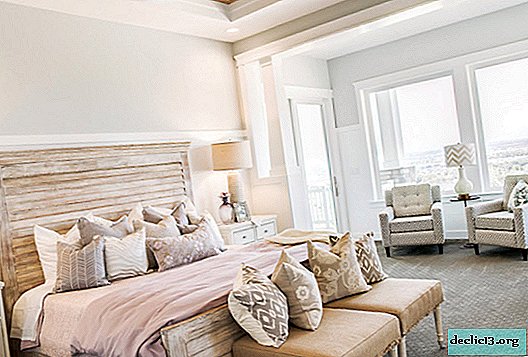Growing and propagating ampelous begonia with cuttings and from seeds. Care Tips

In the past few years, begonias have again returned to fashion, which amaze with their diversity of species and varieties.
To decorate the house, you can not find anything better than an ampel beauty. It is hung in a cache-pot, on open porches, balconies, used for hinged vases, shop windows. The flower looks attractive, and compared to other indoor plants, it is not whimsical to care for.
Flower description
Long thin shoots of the plant are strewn with small colorful flowers, has a spectacular look. The size of inflorescences in diameter is from 2 to 8 cm, depending on the variety. The length of the shoots reaches 40 cm, and in terry and semi-double hybrids, this size is 80 cm.
The flowering period of each inflorescence is at least 10 days. The colors of the ampel begonia can be: white, bright red, pale pink, burgundy, raspberry, pale yellow. You will learn about the types and varieties of begonias with yellow flowers here, and about the bright red beauty read here.
Cascading views are great for decorating street vertical structures.Moreover, the duration of flowering is quite long, from late spring to late autumn. Many hybrid varieties do not lose their attractiveness even with the onset of rains and the first frosts.
How to grow: breeding methods
Beginning amateur gardeners are afraid to breed an ampel beauty on their own, so they often get a ready-made flower in stores. In fact, in reproduction of a plant there is nothing difficult.
Begonia is bred in three main ways.:
- seeds;
- cuttings;
- tuber division (for tuber begonia read here).
Cuttings
This method of all is less troublesome, fast and effective. The percentage of survival of begonia seedlings is quite large. Also, the method allows to obtain samples identical to the mother. Flowering plants may occur even after planting in the ground, but it depends on the variety.
 The vegetative method of propagation of ampelous begonia is divided into the following stages:
The vegetative method of propagation of ampelous begonia is divided into the following stages:
- Preparation of cuttings.
- Processing planting material.
- Rooting.
- Planting a young plant in the ground.
It is recommended to carry out the process of cuttings in mid-spring. In summer, the air temperature is high, which causes some discomfort to the plant.
- As cuttings, sections of the stem 10-12 cm long are used, they must necessarily have at least 3 buds. The operation is carried out exclusively with a sharp knife, diagonally. Leaves must be removed, leaving no more than two, so as not to take away the force from the sprout. Sections should be sprinkled with activated carbon in powder form.
- For the process of root formation, the stalk is placed in water, or placed in a substrate.
If the first method is used, it is recommended to choose containers made of transparent material, not large. This is done so that the shoot not only grows, but also gains strength.
Attention! It is necessary to pay attention so that future roots do not touch the bottom, otherwise they can rot.Water should be soft. The container with the handle is placed in a bright place with a temperature of + 20 ° C. After two weeks, the roots hatch. If you choose a substrate, it should be wet sand, sawdust, peat. In this case, the stalk is dipped in water, and then dipped in a special solution for the rapid development of the root system. Preparations such as "Kornevin", "Zircon".
A pot is selected to the size of the handle, it is buried in a moistened substrate by 2-3 cm. Then the container is covered with a jar, film or glass to create a greenhouse effect. Every day, the pot with the handle should be aired, observed, and watered if necessary. When new leaves appear, the plant is ready.
No need to wait until the big roots grow, it is better to transplant the sprout into fertile, loose soil faster. And put it in a greenhouse, or cover it with a plastic bag for several days.
For transplantation, specially prepared soil for begonias with a neutral pH is chosen. At the bottom of the pot, drainage is laid. To lower the plant carefully, the roots are very fragile so as not to break. Then begonia should be poured with settled warm water.
It will look beautiful if in one pot with a diameter of 12 cm, plant immediately 5 sprouts of ampelous begonia. The bush will look lush and thick.
From seed
The cultivation of ampel begonia is a painstaking task, because it requires constant monitoring. Begin planting seeds in late FebruaryThe deadline is mid-March. The first and important step is the selection of planting material. Seeds are of two types: granular, ordinary.
 For granular seeds, peat tablets are needed as soil. In this case, you can do without picking a plant. Before sowing, spread the tablets on a pallet and moisturize intensively. Then the seed is sown, and sprayed with water, at room temperature, from the spray gun. Cover with polyethylene from above. Watering is carried out regularly through the pan, otherwise, when the soil dries, the seeds will die.
For granular seeds, peat tablets are needed as soil. In this case, you can do without picking a plant. Before sowing, spread the tablets on a pallet and moisturize intensively. Then the seed is sown, and sprayed with water, at room temperature, from the spray gun. Cover with polyethylene from above. Watering is carried out regularly through the pan, otherwise, when the soil dries, the seeds will die.- When choosing ordinary seeds, seedling boxes are chosen as a container. The soil is selected non-acidic, with a mandatory drainage layer. A day before planting seeds, the earth needs to be watered. Seeds are evenly planted in the ground, covered with glass or other translucent material.
Seedling boxes are placed in a room with a temperature of + 22-24 ° C and good lightening. The time of emergence of seedlings varies from 10 to 21 days. After 30-45 days, dive seedlings, transplant into separate cups.
Important! It is necessary to feed young shoots with mineral fertilizers.Watch a video on this landing method.
Landing problems
- A cut of the handle in the water began to rot. It is necessary to remove the handle from the water, cut off the rotten part, put in a container with fresh water.
- Begonia seeds do not peck for a long time. Perhaps the reason for this is dry soil, or low room temperature. Measures should be taken: water the soil, and increase the temperature in the room.
- Seedlings are elongated, becoming long and thin. Plants are clearly lacking in sunlight. If possible, it is worth moving containers with seedlings closer to the light source.
- Slow growth. Maybe the young plant lacks nutrients in the soil, so you should feed it with fertilizers.
Useful tips on planting and caring for ampel begonia can be found here.
Care
To obtain good results in the process of growing ampelous begonia, you should pay attention to the following conditions:
- The optimum temperature and humidity regime in the room should be at the level of + 18-22 ° С, humidity 50-70%.
- Between 11 a.m. and 3 p.m. to evening, begonias need sunlight.
- Humidification is moderate, do not allow the plant to flood with water.
- From the beginning of spring to autumn, it is important to feed the flower. Especially during flowering, fertilizers with a high content of potassium and phosphorus. Twice a year, you can feed organic fertilizers.
- If necessary, pick up dried flowers, loosen the soil, spray, remove dust from the leaves, inspect the plant for pests.
As can be seen from the above, to propagate and grow ampelous begonia on your own is not so difficult. You need to make a little effort, and the ever-flowering beauty will always look elegant and festive. Blossom for the joy of you and others.

 For granular seeds, peat tablets are needed as soil. In this case, you can do without picking a plant. Before sowing, spread the tablets on a pallet and moisturize intensively. Then the seed is sown, and sprayed with water, at room temperature, from the spray gun. Cover with polyethylene from above. Watering is carried out regularly through the pan, otherwise, when the soil dries, the seeds will die.
For granular seeds, peat tablets are needed as soil. In this case, you can do without picking a plant. Before sowing, spread the tablets on a pallet and moisturize intensively. Then the seed is sown, and sprayed with water, at room temperature, from the spray gun. Cover with polyethylene from above. Watering is carried out regularly through the pan, otherwise, when the soil dries, the seeds will die.















